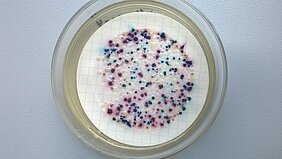Aeromonads as presumptive colonies in the detection of E. coli/coliform bacteria can cause discussions with health authorities about their possible hygienic relevance.
Aeromonads can occur as presumptive colonies in the detection of E. coli/coliform bacteria according to DIN 9308-1 on CCA plates. Pink-colored colonies with a negative oxidase reaction are considered "coliform bacteria". If, on the other hand, pink-colored colonies show a positive oxidase reaction, they are usually Aeromonas species. These are not regulated in the Drinking Water Ordinance and are generally not classified as pathogens. However, there is discussion that some special species, for instance Aeromonas hydrophila, have pathogenicity factors and should therefore be considered as pathogens. In order to check this hygienic relevance, health authorities often ask for species identification with MALDI-TOF-MS when accompanying flora is found on CCA plates. However, reliable identification is currently only possible at genus level, i.e. "Aeromonas spp.". This is regarded critically by some health authorities, as it could also be Aeromonas hydrophila as well. In this respect, water supply companies sometimes have discussions on the assessment of aeromonads in drinking water due to these presumptive colonies as accompanying flora in routine drinking water samples in the network.
As part of the "Aeromonads in drinking water supply" project, an assessment is to be developed for the water supply companies, which they can use as an argumentation aid for cooperation with the health authorities. From previous work at TZW, it is known that many water supply companies can be affected by this problem. The concentrations vary greatly and range from 1 CFU per 100 mL to > 1,000 CFU per 100 mL.
The following questions will be addressed in the project:
- Which Aeromonas species occur in drinking waters and what is their hygienic relevance?
- Why do large concentration differences occur in the various drinking waters?
- Which factors can be regarded as possible causes and which water utilities must therefore expect their occurrence?
- How can these causes possibly be minimized or stopped?
After research on the international state of knowledge and handling of aeromonad findings, the practical relevance in Germany will be analyzed by examining water and sediment samples as well as invertebrates from the drinking water network. In three participating water supply companies, water samples will be taken regularly at the waterworks outlet and in the pipe network and analyzed for aeromonads. The raw water spectrum of the waterworks ranges from deep groundwater to bank filtrate, karst spring water, reservoir water and river water.
Further molecular-biological investigations are required to clearly classify the species. The molecular method developed for identification at species level will be used to determine which Aeromonas species are present in the various drinking water samples.
In order to investigate the causes for the occurrence of Aeromonas, the waters with very high and very low Aeromonas concentrations will be characterized by organic sum parameters (e.g. LC-OCD, AOC) and laboratory tests will be carried out to clarify the proliferation conditions for different Aeromonas species. Countermeasures are tested and discussed according to the possible causes.
Finally, a guideline for water suppliers will be developed from the knowledge gained.

![[Translate to English:] Prüfstelle-Produktprüfung_Teststand Test centre and product testing](/fileadmin/_processed_/0/9/csm_TZW-Karlsruhe_Pruefung_Geraete-Teststand_377188946c.jpg)

























